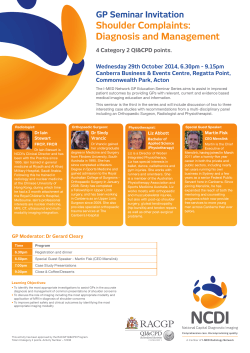
Use of upper and lower case letters Word/terms Rule
DEAKIN UNIVERSITY GOVERNANCE UNIT | 1 Use of upper and lower case letters Word/terms Rule Relevant Example Agenda Use upper case when using the full name of an agenda. Use lower case in all other instances. To receive all unstarred items on the agenda and approve… Use upper case when using the full name of an agenda. Use lower case in all other instances. To confirm the minutes of the meeting. Use upper case when using the word as the name of a particular meeting. Use lower case in all other instances. To confirm the minutes of Meeting 2, 2012. Terms of reference Use lower case. The PRC terms of reference was amended. Business schedule and action sheet Use lower case. The committee reviewed the business schedule and action sheet. Conflict of interest Use lower case. There was a potential conflict of interest. Composition and membership Use lower case. The PRC composition and membership could be found… Business arising Use lower case. To consider business arising from the minutes… Procedural matters Use lower case for subheadings. Procedural matters Other matters Use lower case for subheadings. Other matters Intellectual property Lower case when written in full and upper case when abbreviated. The intellectual property(IP) was … Meeting schedule, agenda deadline schedule Use lower case. The University meeting schedule/agenda deadline schedule was circulated. Chair Use upper case when referring to a specific Chair and lower case when using it as a general title. The Chair noted that… Meeting The committee noted that all members attended the meeting. The election for a chair commenced… 2 | DEAKIN UNIVERSITY GOVERNANCE UNIT University Use upper case when referring to Deakin as the University or Deakin University. Use lower case when referring to university in general. The University was represented by…. Committee If the word committee is used in place of a full committee name use upper case C. It was noted by the Committee… Headings and subheadings Do not use capitals in headings or subheadings unless it is the first word or a noun. Use of acronyms hh When using an acronym spell it out in full the first time that it is used and then use the acronym from then on. hh When using an acronym for a committee do not preface it with ‘the’. Example: The document will come to PRC. Not: The document will come to the PRC. hh When using the full committee name you would preface it with ‘the’. Example: The document will come to the Planning and Resources Committee. Deakin Editorial Style Guide The Deakin Editorial Style Guide is the first place to look if you have a query about editorial issues. The guide is accessible at deakin.edu.au >Staff intranet>Services>Marketing>Visual and editorial style guide. Following is an excerpt from the Deakin Editorial Style Guide on the use of capital letters: Capital letters signify specific or proper names and distinguish these from general or common names. Titles of books and journals, days of the week, months of the year, names of places, nationalities, proprietary names and trademarks and forms of address are normally given capitals. Use minimal capitalisation in headings or subheadings. Use lower case after a colon between a heading and subheading, e.g. Assessment regulations: special consideration. University always takes a capital when referring to Deakin University, e.g. the University, but is lower case when used generically, e.g. He decided that he would go to university. For University purposes, structural areas of the University such as Faculties, Schools and Divisions should be capitalised for all references whether specific or general, e.g. The Faculty of Arts and Education has scheduled a meeting for Monday morning, and Some Faculties have indicated this arrangement is not suitable. DEAKIN UNIVERSITY GOVERNANCE UNIT | 3 In general, use lower case for generic positions but capitals for specific job titles, e.g. a committee chairperson (generic): the Faculty Academic Secretary of Health (specific): a course materials editor (generic). The exception to this is Vice-Chancellor, which is always capitalised, e.g. Vice-Chancellor Professor Jane den Hollander (specific) chaired the committee; and Professor Sally Walker served as Vice-Chancellor (generic) until 2010. Capitalise the full name of venues, e.g. KD Stewart Centre or the Deakin University Art Gallery. Deakin’s style requires campus and campuses (when used generically) to be lower case. Proper, official campus names are to be capitalised, e.g. the campus is in Burwood, but the Melbourne Burwood Campus. References to trimesters are upper case when referring to specific trimesters, but lower case when used generically, e.g. Trimester 1 students … but The academic year at Deakin is divided into trimesters. Levels are lower case, e.g. level 1. When referring to courses, capitalisation occurs when full course titles are used, e.g. Bachelor of Nursing or Bachelor of Arts (Honours) or full unit titles are used, e.g. the Research Methodology unit. No capitalisation should be used when: hh specialisations or major sequences are mentioned, e.g. specialisations/major sequences are available in accounting, arts and entertainment management, corporate governance hh the area of study is mentioned , e.g. practice within critical care areas of nursing hh referring to units generically, e.g. select two nursing units hh course content is described generally, e.g. within this course students will look at areas such as biochemistry, physiology and food science hh course/study areas or disciplines are referred to generally (not the full title of a course), e.g. the postgraduate suite of tourism management courses, students will learn aspects of information technology and advanced engineering in an industrial context or this course exposes law graduates to... hh a job title is used, e.g. you may find employment as a teacher hh referring generically to an honours course. In basic terms, the only time a course is capitalised is when its full title is used, e.g. Bachelor of Arts. For more information on capitalisation, see the Style Manual, ch. 8 p. 118.
© Copyright 2025





















